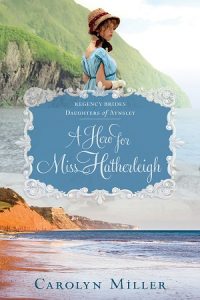There are a lot of details in this novel—including historical as well as scientific details. What kind of research did you need to do for this novel?
 I spent a great deal of time researching reference books and searching online articles about both the setting (Sidmouth, in south-east Devonshire) and the progression of scientific research in the Regency period, particularly as it relates to geology and the beginnings of paleontology.
I spent a great deal of time researching reference books and searching online articles about both the setting (Sidmouth, in south-east Devonshire) and the progression of scientific research in the Regency period, particularly as it relates to geology and the beginnings of paleontology.
One of my favorite finds (which I refer to in the novel) was the 1810 pictorial guide The Beauties of Sidmouth Displayed, by Edmund Butcher, which was a fabulous account of Sidmouth from two hundred years ago.
What was the most challenging part for you when writing the story?
This story had a few challenges. I’m not a scientist, so dealing with some of the scientific elements was interesting at times, especially when some of the information was not easy to discover.
Likewise trying to balance the use of Regency-era terms with what readers understand today. It’s a tricky balance between historical accuracy and having readers think I’ve misspelled a word!
I think the most challenging aspect was trying to write it so it would link with a story written several years ago and have a consistent flow of characterization and style—all while looking after my four children while on summer holidays from school!
Fact vs. Fiction: What liberties (if any) did you take with historical facts to make A Hero for Miss Hatherleigh work?
 Some of the landscape has eroded over the past 200 hundred years, so I’ve tried for a balance between what historical records suggest existed in Sidmouth’s surrounds with what people can see today. Also (spoiler alert!) the ichthyosaurus Gideon discovers is loosely based on discoveries at that time.
Some of the landscape has eroded over the past 200 hundred years, so I’ve tried for a balance between what historical records suggest existed in Sidmouth’s surrounds with what people can see today. Also (spoiler alert!) the ichthyosaurus Gideon discovers is loosely based on discoveries at that time.
I wanted to move the scene from the fossil-rich Jurassic-era cliffs of Lyme Regis (familiar to admirers of Jane Austen’s Persuasion) to the lesser known Sidmouth area, but the cliffs and geology of that region are of Triassic-era formation. I felt like it was an answer to prayer when in 2017 the largest ichthyosaurus found in the UK was found in Triassic-era cliffs directly north of Sidmouth—which lent weight to the idea that such things could be found around the Sidmouth area also.
I want to be accurate as much as possible—but I hope readers also understand this is fiction!
Click through to find out what to expect from this new Regency romance series!


